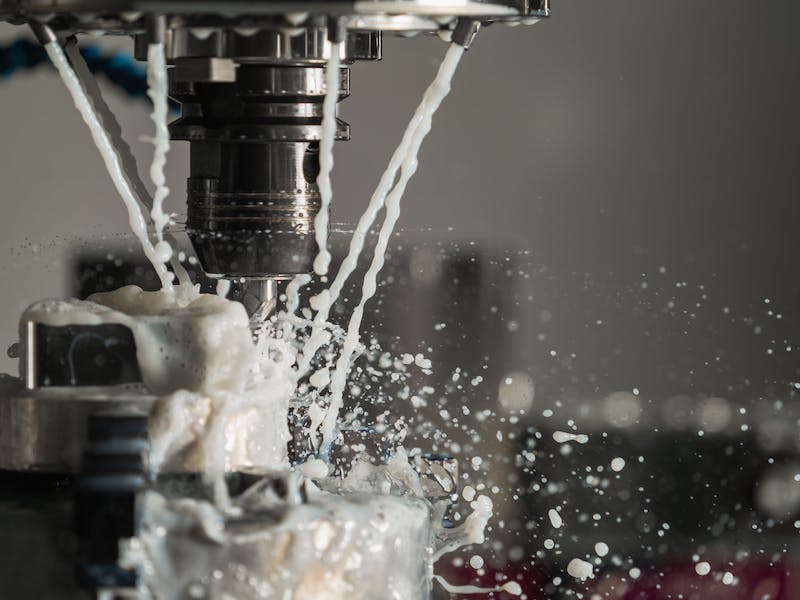Cleaning has always impressed me as the most critical step in any surface finishing process. It is universally the first step.
That makes cleaning the most important step. If this part of surface preparation is not done right, all the subsequent treatments, leading up to the final step, could very well result in rejects.
 Stephen Rudy, CEFCleaning encompasses the removal of substances from the fabricating, assembly, or surface treatments, that parts are subjected to. These materials or soils may range from (organic types) oils and grease to metallic (shavings, imbedded particles, oxides, rust, and scales). In many instances, soils may comprise various combinations on parts. The types of soils on parts, coupled with the widely divergent mix of parts and finishing requirements, readily elevates effective cleaning to the importance it commands.
Stephen Rudy, CEFCleaning encompasses the removal of substances from the fabricating, assembly, or surface treatments, that parts are subjected to. These materials or soils may range from (organic types) oils and grease to metallic (shavings, imbedded particles, oxides, rust, and scales). In many instances, soils may comprise various combinations on parts. The types of soils on parts, coupled with the widely divergent mix of parts and finishing requirements, readily elevates effective cleaning to the importance it commands.
Environmental compliance, safety issues, and economics, add another facet to the importance of cleaning. The type of cleaning selected must also provide the optimum surface treatment, such as detergency or conditioning, to provide clean parts for the next step. Let us review some of these water based cleaning processes.
Soak Cleaning
This is by far the most common procedure. Almost all plating lines, rack and barrel, start with a soak cleaner. The water-based solution is prepared and maintained with a vendor supplied concentrate that is aqueous or powder. Depending on the base metals of parts being cleaned, the solution pH may be important. In this respect aluminum requires cleaning in a solution pH below 10 to prevent base metal etching. Brass and zinc must be cleaned in a solution pH below 14 (no caustic), to prevent etching. Steel, stainless, and copper can be cleaned in a wide range of solution pH above 9, that is if the cleaner will effectively remove the soils. Surfactants and wetting agents comprise the main contributors to removing a wide range of organic soils. The pH of the working solution may have a strong effect on how the detergency additives perform. There are usually balanced ratios of nonionc, anionic, and cationic species in the concentrate. There has been a push in the past two decades to incorporate more and more biodegradable detergency additives.
Cleaning to remove organic soils may be accomplished by either emulsification (surrounding soils and binding them) or by displacement (replacing the soil from the substrate surface). Most emulsifying blends may hold from 5 to 10 percent by volume of oils and grease before the solution must be replaced with a fresh make up.
Consequently, displacement cleaning continually removes the oils and grease. These soils being normally less dense than water, will float, and can be continually removed, extending the service life of the working cleaner bath.
Alkali builders also contribute to improved cleaning. These include caustic (sodium or potassium hydroxide), carbonate, sesquicarbonate, complex phosphates, and silicates. Solvent additives, such as the ethylene and propylene glycol ethers, are also very effective cleaning agents. Water hardness conditioners keep surfactants from being consumed by calcium and magnesium, thus freeing them for intended cleaning purposes. Soak cleaners are typically heated for best cleaning results. Depending on the intended application and formulation of the cleaner concentrate, the solution may be heated from 120–180°F (49–82°C). Mechanical agitation is very helpful to dislodging soils. Optimum cleaner formulations, operating at the best parameters, will usually remove soils within 3–5 minutes.
Electrocleaning
The application is similar to the soak cleaner, except the focus is on removal of metallic soils. Just about every plating line incorporates an electrocleaning step into surface preparation.
First and foremost is the use of DC power to remove these soils. Electrolysis of water forms oxygen gas bubbles at the anode and hydrogen gas bubbles at the cathode. Electocleaning is predominantly anodic, indicating the parts are anodic, or positively charged. Oxygen gas bubbles that are formed on the parts actively scrub the surface, removing metallic soils. Oxides and rust are either removed or significantly softened prior to complete removal in the acid dip.
Although there are two parts of hydrogen formed for every part of oxygen in the hydrolysis of water, anodic cleaning is preferred. If the parts were cathodically cleaned, positively charged contaminants, such as dissolved metals, would plate out as a smut, thereby making the parts more dirty or soiled.
Electrocleaners are formulated as liquid or powder concentrates. Because of scope and application, the chemical composition of the electrocleaner varies from that of the soak cleaner. The electrocleaner contains caustic, which is necessary for solution conductivity. Electrocleaners for steel and stainless typically contain the most caustic to provide the higher current densities required for descaling and derusting. Brass and zinc electrocleaners contain less caustic, along with a balance of inhibitors (such as silicates, phosphates, and borates), that prevent etching of these sensitive base metals.
Incidentally, because of it’s acute sensitivity to alkalinity and being the most electropositive metal, aluminum is never electrocleaned. Since the bulk of organic soil removal occurs in the soak cleaner, the electrocleaner only contains small quantities of surfactants and wetting agents. The lower quantities of these additives provide
sufficient reserve cleaning for organic soils and form a thin, stable foam blanket to prevent corrosive solution misting. As described, higher levels of the inhibitors are required to protect the base metal from burning, pitting, and etching.
Conditioners such as gluconates, glucoheptonates, polyphosphates, and substituted amines, effectively attack scales and rust. Reducing agents, which include complex sugars and thiosulfates, prevent the harmful buildup of contaminating metals, such as hexavalent chromium. Electrocleaners are normally used hot, 150–190°F (66–88°C).
Current densities vary depending on rack or barrel, ferrous or non-ferrous metals. Values may range from 5 A/ft2 to 125 A/ft2. Mechanical agitation is preferred to circulate fresh solution and help to maintain solution temperature throughout the bath. Time depends on the cleaning intensity and operating parameters. This would usually range from 2–5 minutes.
In some plating installations, double cleaning cycles are used (first electrocleaner—first acid—second electrocleaner—second acid). These extra steps normally insure that complete soil removal has been achieved. In some installations, space allocation is tight. To compensate, combination soak and electrocleaning may be accomplished in one process tank. Of course, this is fine if the formulation is appropriate for both applications. For heavy duty descaling, periodic reverse treatment is very effective. In this method, the parts alternate from anodic to cathodic finally exiting as anodically (deplating smuts in the last step) charged.
Ferrous and non-ferrous continuous strip is usually cleaned by this method, passing charged plates that are fixed above and below the sheet. Electrocleaning is accomplished inductively.
Spray Cleaning
This cleaning method takes advantage of mechanical energy that is provided by pumping the cleaning solution through spray nozzles. The impact facilitates the action of surfactants and wetting agents to loosen and remove organic soils. Ferrous and non-ferrous metals are cleaned by this method. It is usually employed as part of a multistage process, as part of a phosphate or an organic coating, such as paint or powder coat. There are general formulation similarities to the soak cleaner. However lower concentrations of surfactants, wetting agents, and conditioners are appropriate, because of the spray impact action in cleaning. Low foaming surfactants are important in the formulation, as are defoaming agents. Water hardness conditioners are very important. These additives prevent the plugging of spray nozzles and minimize buildup of scale inside the spraying station. Displacement cleaning is preferred, since the cleaner is circulated through a settling tank. This allows displaced oils and grease to settle out or be removed by mechanical separation devices.
Ultrasonic Cleaning
This method uses a transducer to introduce high frequency sound waves into the cleaner bath. It results in the formation of minute bubbles, as the sound waves pass through the solution. As waves continually pass through each specific area of solution, tremendous pressure builds up on these bubbles, causing them to implode. The implosion occurs on the surface of the part being cleaned, thereby blasting soils off the substrate. This energy greatly facilitates the cleaning action of the chemical constituents of the cleaner. Cleaning is very effective on tough soils. These include buffing & polishing compounds, dried on or baked soils. Cavitation and implosion action reaches into minute crevices, inside tight geometric shapes, and inside tubing.
Ultrasonic cleaning picks up where other mechanical cleaning methods may fall short. Cleaner concentrates are in liquid and powder form. Working solutions normally have a pH between 9 and 10, since many candidate parts are non-ferrous metals (such as brass, zinc, and aluminum). In fact, many such parts have been highly polished. Therefore any discoloration or etching of the surface metal is prohibitive. Surfactants having specific HLB values, soaps, buffers, fatty acids, and glycol ethers, may comprise concentrate formulations.
The investment in ultrasonic cleaning equipment is expensive. But where it fits, it is an outstanding cleaning method. It requires a generator to convert line power to 20–80 kHz. A transducer introduces mechanical energy into the solution from an electrical energy source. Precision cleaning of highly polished parts such as jewelry, plumbing, and automotive, are some examples for application of ultra- sonic cleaning. Ultrasonic cleaning may range in application from 140–160°F (60–71°C). Time usually required is 2–5 minutes.
Cleaning alternatives are specialized to meet the required demands. Processes have been developed along with cleaner formulations. Operating per the recommended parameters, for specific cleaning applications should provide the expected cleaning effectiveness. Plan it right. Do it right. There is no equal to effective cleaning.
Stephen F. Rudy, CEF, is president of Chem Analytic, and has written extensively about the finishing industry. Visit www.chemanalytic.com or call him at 917-604-5001.



































